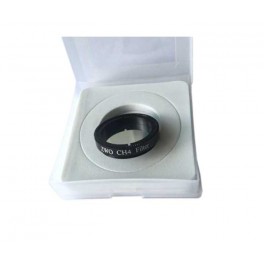
 Ingrandisci
Ingrandisci Methane Band CH4 da 31.8mm
ASI - ZWoptical
- Rimuovi questo prodotto dai miei preferiti
- Aggiungi questo prodotto ai miei preferiti.
- Stampa
ZWO 1.25" Methane Band CH4 Filter - 20 nm FWHM

 Ingrandisci
Ingrandisci ZWO 1.25" Methane Band CH4 Filter - 20 nm FWHM
Codice articolo: ZWO-CH4
ZWO 1.25" filter for photographing planets like Jupiter or Saturn with infrared sensitive cameras
♦ The filter is only suitable for photography, as the transmission range is beyond the sensitivity range of the human eye.
♦ We recommend an IR sensitive camera like the ASI224MC or ASI185MC.
♦ The narrowband filter opens at 880 nm, rises rapidly and closes at 900 nm - it only lets the methane band pass.
♦ The images of Jupiter and Saturn were taken through a similar methane band filter by our staff member Andy Murner.
![ZWO 1.25" Methane Band CH4 Filter - 20 nm FWHM [EN] ZWO 1.25" Methane Band CH4 Filter - 20 nm FWHM [EN]](https://www.teleskop-express.it/img/cms/zwo-methane-band-filter.jpg)
ZWO 1.25" Methane Band Filter for planetary imaging
This filter is designed for planet photographers. Spectacular images of Jupiter, Saturn, etc. are possible. Visual observations are not possible, as the human eye is is not sensitive in this spectral region anymore.
The atmospheres of the giant planets contain a significant amount of methane which absorbs infrared radiation in a narrow range. As this filter only transmit in this range, the planets appear darker. To be more specific: as methane forms a layer, structures below it look darker, whereas structures above it look brighter.
![ZWO 1.25" Methane Band CH4 Filter - 20 nm FWHM [EN] ZWO 1.25" Methane Band CH4 Filter - 20 nm FWHM [EN]](https://www.teleskop-express.it/img/cms/zwo-ch4-methan-band.jpg)
Features close to and on Jupiter
The moons are clearly distinguishable from the planet disc and will not be outshone if standing close to it. Now it is possible to notice weaker moons.
The Great Res Spot and similar rotating storms appear bright, so the altter can be seen during their formation.
An additional equatorial zone becomes visible, but also layers of mist high above the poles.
Also, there are bright spots distributed over the planet. This a high-rising clouds, presumably the top parts of thunderstorms.
Finally, impact structures may also appear bright here, whereas the look dark in broadband infrared.
![ZWO 1.25" Methane Band CH4 Filter - 20 nm FWHM [EN] ZWO 1.25" Methane Band CH4 Filter - 20 nm FWHM [EN]](https://www.teleskop-express.it/img/cms/asi-ch4-andy-murner-sat-20130617-2330a.jpg)
Features close to and on Saturn
Also in this case, the moons are clearly distinguishable from the planet disc and will not be outshone if standing close to it. The exception is Titan - it has a dense atmosphere with a significant amount of methane, making it looking very dark - usually invisible.
Of course, the showpiece is the ring, which now becomes the brightest object and can easily be distinguished from the planet disc.
The equatorial area also looks brighter, but to the amount of Jupiter´s one.
![ZWO 1.25" Methane Band CH4 Filter - 20 nm FWHM [EN] ZWO 1.25" Methane Band CH4 Filter - 20 nm FWHM [EN]](https://www.teleskop-express.it/img/cms/asi-ch4-andy-murner-jup-20130128-1910met-1000.jpg)
Also important, besides the filter:
The requirement for a successful use is a camera which is sensitive for infrared light, like the ASI224MC, but also DSLR cameras where the IR blocking filter was removed without substitution.
As the filter is relatively dark, a larger apperture of 200 mm (8") or more is recommended, so reflectors have an advantage. That they do not absorb IR radiation and the focus is at the same distance for all wavelengths, belongs also to the positive aspects.
